Mohammed Khalilia
Konooz: Multi-domain Multi-dialect Corpus for Named Entity Recognition
Jun 14, 2025Abstract:We introduce Konooz, a novel multi-dimensional corpus covering 16 Arabic dialects across 10 domains, resulting in 160 distinct corpora. The corpus comprises about 777k tokens, carefully collected and manually annotated with 21 entity types using both nested and flat annotation schemes - using the Wojood guidelines. While Konooz is useful for various NLP tasks like domain adaptation and transfer learning, this paper primarily focuses on benchmarking existing Arabic Named Entity Recognition (NER) models, especially cross-domain and cross-dialect model performance. Our benchmarking of four Arabic NER models using Konooz reveals a significant drop in performance of up to 38% when compared to the in-distribution data. Furthermore, we present an in-depth analysis of domain and dialect divergence and the impact of resource scarcity. We also measured the overlap between domains and dialects using the Maximum Mean Discrepancy (MMD) metric, and illustrated why certain NER models perform better on specific dialects and domains. Konooz is open-source and publicly available at https://sina.birzeit.edu/wojood/#download
An Empirical Evaluation of Encoder Architectures for Fast Real-Time Long Conversational Understanding
Feb 18, 2025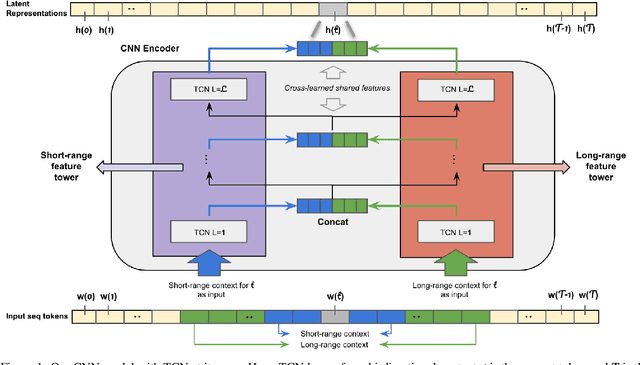
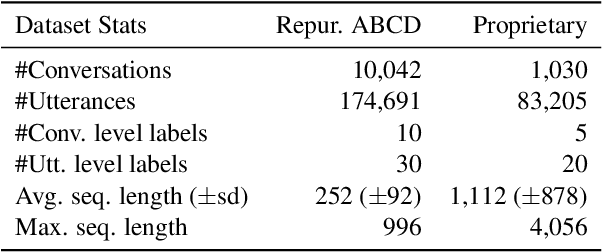
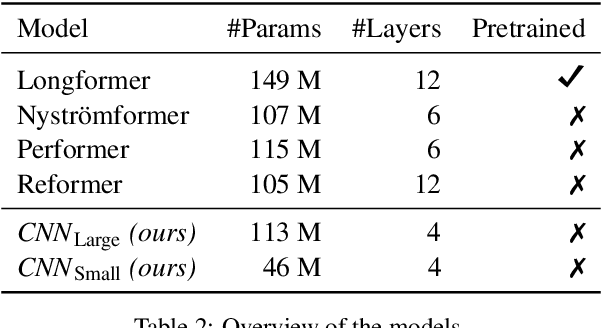
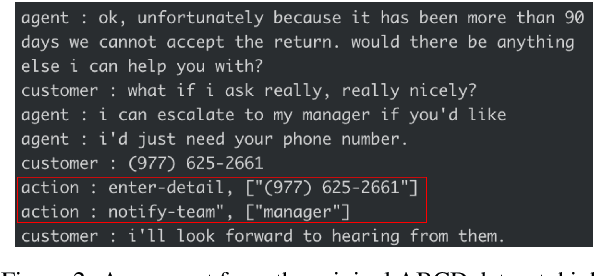
Abstract:Analyzing long text data such as customer call transcripts is a cost-intensive and tedious task. Machine learning methods, namely Transformers, are leveraged to model agent-customer interactions. Unfortunately, Transformers adhere to fixed-length architectures and their self-attention mechanism scales quadratically with input length. Such limitations make it challenging to leverage traditional Transformers for long sequence tasks, such as conversational understanding, especially in real-time use cases. In this paper we explore and evaluate recently proposed efficient Transformer variants (e.g. Performer, Reformer) and a CNN-based architecture for real-time and near real-time long conversational understanding tasks. We show that CNN-based models are dynamic, ~2.6x faster to train, ~80% faster inference and ~72% more memory efficient compared to Transformers on average. Additionally, we evaluate the CNN model using the Long Range Arena benchmark to demonstrate competitiveness in general long document analysis.
SinaTools: Open Source Toolkit for Arabic Natural Language Processing
Nov 03, 2024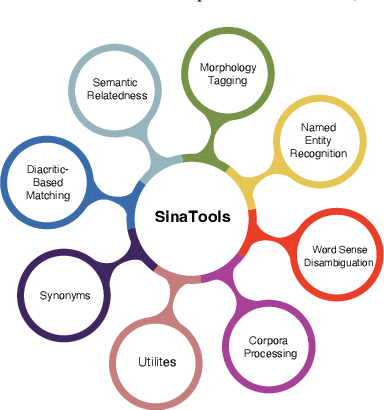
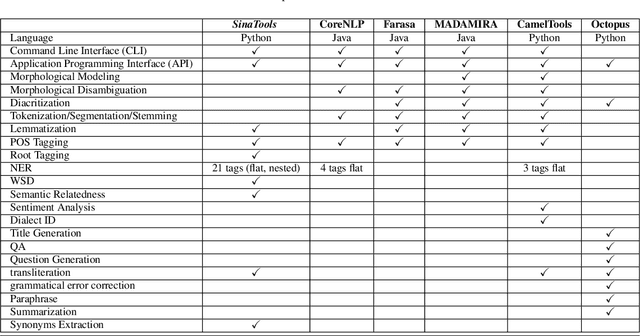

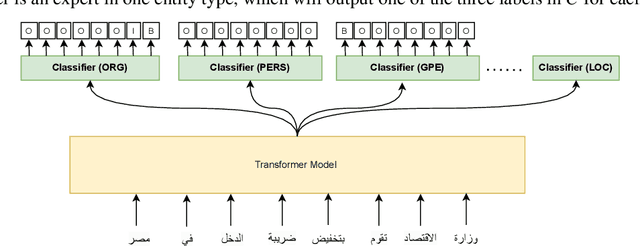
Abstract:We introduce SinaTools, an open-source Python package for Arabic natural language processing and understanding. SinaTools is a unified package allowing people to integrate it into their system workflow, offering solutions for various tasks such as flat and nested Named Entity Recognition (NER), fully-flagged Word Sense Disambiguation (WSD), Semantic Relatedness, Synonymy Extractions and Evaluation, Lemmatization, Part-of-speech Tagging, Root Tagging, and additional helper utilities such as corpus processing, text stripping methods, and diacritic-aware word matching. This paper presents SinaTools and its benchmarking results, demonstrating that SinaTools outperforms all similar tools on the aforementioned tasks, such as Flat NER (87.33%), Nested NER (89.42%), WSD (82.63%), Semantic Relatedness (0.49 Spearman rank), Lemmatization (90.5%), POS tagging (97.5%), among others. SinaTools can be downloaded from (https://sina.birzeit.edu/sinatools).
ArabicNLU 2024: The First Arabic Natural Language Understanding Shared Task
Jul 30, 2024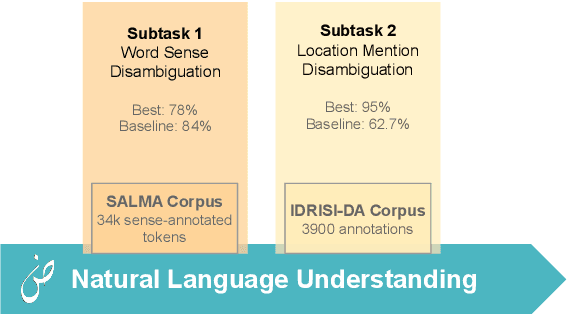

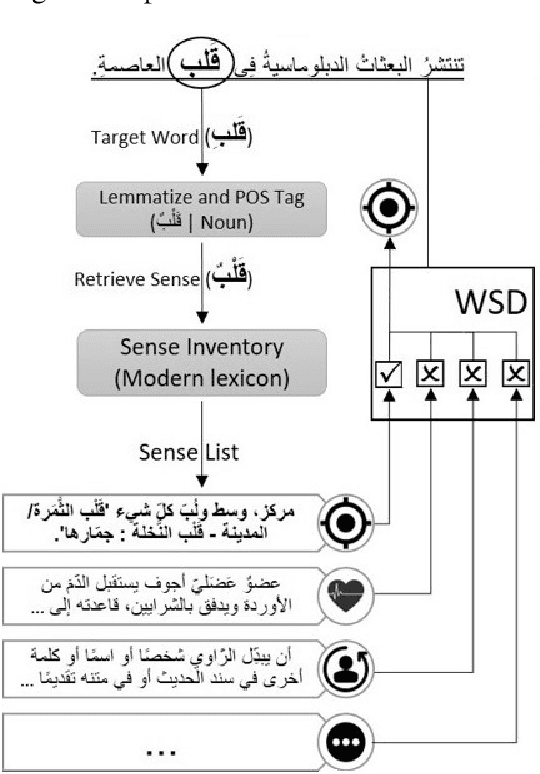
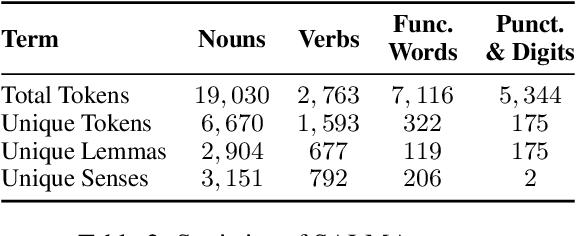
Abstract:This paper presents an overview of the Arabic Natural Language Understanding (ArabicNLU 2024) shared task, focusing on two subtasks: Word Sense Disambiguation (WSD) and Location Mention Disambiguation (LMD). The task aimed to evaluate the ability of automated systems to resolve word ambiguity and identify locations mentioned in Arabic text. We provided participants with novel datasets, including a sense-annotated corpus for WSD, called SALMA with approximately 34k annotated tokens, and the IDRISI-DA dataset with 3,893 annotations and 763 unique location mentions. These are challenging tasks. Out of the 38 registered teams, only three teams participated in the final evaluation phase, with the highest accuracy being 77.8% for WSD and the highest MRR@1 being 95.0% for LMD. The shared task not only facilitated the evaluation and comparison of different techniques, but also provided valuable insights and resources for the continued advancement of Arabic NLU technologies.
Event-Arguments Extraction Corpus and Modeling using BERT for Arabic
Jul 30, 2024
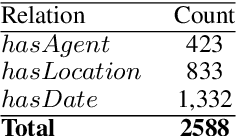
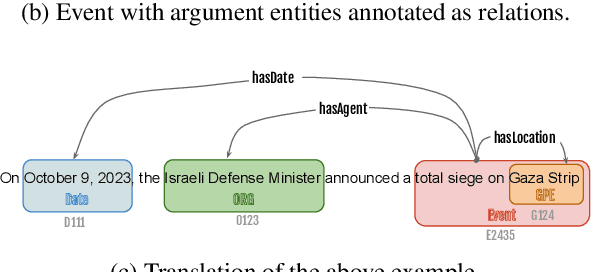

Abstract:Event-argument extraction is a challenging task, particularly in Arabic due to sparse linguistic resources. To fill this gap, we introduce the \hadath corpus ($550$k tokens) as an extension of Wojood, enriched with event-argument annotations. We used three types of event arguments: $agent$, $location$, and $date$, which we annotated as relation types. Our inter-annotator agreement evaluation resulted in $82.23\%$ $Kappa$ score and $87.2\%$ $F_1$-score. Additionally, we propose a novel method for event relation extraction using BERT, in which we treat the task as text entailment. This method achieves an $F_1$-score of $94.01\%$. To further evaluate the generalization of our proposed method, we collected and annotated another out-of-domain corpus (about $80$k tokens) called \testNLI and used it as a second test set, on which our approach achieved promising results ($83.59\%$ $F_1$-score). Last but not least, we propose an end-to-end system for event-arguments extraction. This system is implemented as part of SinaTools, and both corpora are publicly available at {\small \url{https://sina.birzeit.edu/wojood}}
AraFinNLP 2024: The First Arabic Financial NLP Shared Task
Jul 13, 2024



Abstract:The expanding financial markets of the Arab world require sophisticated Arabic NLP tools. To address this need within the banking domain, the Arabic Financial NLP (AraFinNLP) shared task proposes two subtasks: (i) Multi-dialect Intent Detection and (ii) Cross-dialect Translation and Intent Preservation. This shared task uses the updated ArBanking77 dataset, which includes about 39k parallel queries in MSA and four dialects. Each query is labeled with one or more of a common 77 intents in the banking domain. These resources aim to foster the development of robust financial Arabic NLP, particularly in the areas of machine translation and banking chat-bots. A total of 45 unique teams registered for this shared task, with 11 of them actively participated in the test phase. Specifically, 11 teams participated in Subtask 1, while only 1 team participated in Subtask 2. The winning team of Subtask 1 achieved F1 score of 0.8773, and the only team submitted in Subtask 2 achieved a 1.667 BLEU score.
WojoodNER 2024: The Second Arabic Named Entity Recognition Shared Task
Jul 13, 2024Abstract:We present WojoodNER-2024, the second Arabic Named Entity Recognition (NER) Shared Task. In WojoodNER-2024, we focus on fine-grained Arabic NER. We provided participants with a new Arabic fine-grained NER dataset called wojoodfine, annotated with subtypes of entities. WojoodNER-2024 encompassed three subtasks: (i) Closed-Track Flat Fine-Grained NER, (ii) Closed-Track Nested Fine-Grained NER, and (iii) an Open-Track NER for the Israeli War on Gaza. A total of 43 unique teams registered for this shared task. Five teams participated in the Flat Fine-Grained Subtask, among which two teams tackled the Nested Fine-Grained Subtask and one team participated in the Open-Track NER Subtask. The winning teams achieved F-1 scores of 91% and 92% in the Flat Fine-Grained and Nested Fine-Grained Subtasks, respectively. The sole team in the Open-Track Subtask achieved an F-1 score of 73.7%.
NLU-STR at SemEval-2024 Task 1: Generative-based Augmentation and Encoder-based Scoring for Semantic Textual Relatedness
May 01, 2024Abstract:Semantic textual relatedness is a broader concept of semantic similarity. It measures the extent to which two chunks of text convey similar meaning or topics, or share related concepts or contexts. This notion of relatedness can be applied in various applications, such as document clustering and summarizing. SemRel-2024, a shared task in SemEval-2024, aims at reducing the gap in the semantic relatedness task by providing datasets for fourteen languages and dialects including Arabic. This paper reports on our participation in Track A (Algerian and Moroccan dialects) and Track B (Modern Standard Arabic). A BERT-based model is augmented and fine-tuned for regression scoring in supervised track (A), while BERT-based cosine similarity is employed for unsupervised track (B). Our system ranked 1st in SemRel-2024 for MSA with a Spearman correlation score of 0.49. We ranked 5th for Moroccan and 12th for Algerian with scores of 0.83 and 0.53, respectively.
ArBanking77: Intent Detection Neural Model and a New Dataset in Modern and Dialectical Arabic
Oct 29, 2023Abstract:This paper presents the ArBanking77, a large Arabic dataset for intent detection in the banking domain. Our dataset was arabized and localized from the original English Banking77 dataset, which consists of 13,083 queries to ArBanking77 dataset with 31,404 queries in both Modern Standard Arabic (MSA) and Palestinian dialect, with each query classified into one of the 77 classes (intents). Furthermore, we present a neural model, based on AraBERT, fine-tuned on ArBanking77, which achieved an F1-score of 0.9209 and 0.8995 on MSA and Palestinian dialect, respectively. We performed extensive experimentation in which we simulated low-resource settings, where the model is trained on a subset of the data and augmented with noisy queries to simulate colloquial terms, mistakes and misspellings found in real NLP systems, especially live chat queries. The data and the models are publicly available at https://sina.birzeit.edu/arbanking77.
SALMA: Arabic Sense-Annotated Corpus and WSD Benchmarks
Oct 29, 2023Abstract:SALMA, the first Arabic sense-annotated corpus, consists of ~34K tokens, which are all sense-annotated. The corpus is annotated using two different sense inventories simultaneously (Modern and Ghani). SALMA novelty lies in how tokens and senses are associated. Instead of linking a token to only one intended sense, SALMA links a token to multiple senses and provides a score to each sense. A smart web-based annotation tool was developed to support scoring multiple senses against a given word. In addition to sense annotations, we also annotated the corpus using six types of named entities. The quality of our annotations was assessed using various metrics (Kappa, Linear Weighted Kappa, Quadratic Weighted Kappa, Mean Average Error, and Root Mean Square Error), which show very high inter-annotator agreement. To establish a Word Sense Disambiguation baseline using our SALMA corpus, we developed an end-to-end Word Sense Disambiguation system using Target Sense Verification. We used this system to evaluate three Target Sense Verification models available in the literature. Our best model achieved an accuracy with 84.2% using Modern and 78.7% using Ghani. The full corpus and the annotation tool are open-source and publicly available at https://sina.birzeit.edu/salma/.
 Add to Chrome
Add to Chrome Add to Firefox
Add to Firefox Add to Edge
Add to Edge